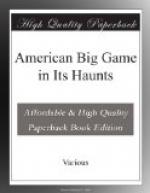Again it rained hard during the night and continued well on into the next morning, so we made a late start, breaking camp at eight o’clock. Spruce, alders, willows, and birch were the trees growing along the banks, and we now passed through the country where the moose range during the summer months. Already the days had become perceptibly shorter, and there was also a feeling of fall in the air, for summer is not long in this latitude.
At this point in the river we encountered bad water, and all hands were constantly wet, while the natives were in the glacial stream up to their waists for hours at a time. Therefore we made but little progress. That night there was a heavy frost, and the next morning dawned bright and clear. The day was a repetition of the day before, and the natives were again obliged to wade with the tow-line most of the way. But they were a good-natured lot, and seemed to take their wetting as a matter of course. About ten o’clock the next morning we reached the Kenai Rapids, where the stream narrows and the water is extremely bad, for the current is very swift and the channel full of rocks. We navigated this place safely and came out into the smooth water beyond. Here we had tea and a good rest, for we felt that the hardest part of this tiresome journey was over. Above the rapids there are a few short stretches of less troubled water where the oars can be used; but these are few and far between, and one must count upon warping the boat from tide water to within two miles of the lake—an estimated distance of between thirty-five and forty miles.
We had hardly got started the following day before it began to rain heavily. We were soon wet to the skin and thoroughly chilled, but we kept on until late in the afternoon, when we camped in a small Indian cabin some three miles from the lake.
It stormed hard during the night with such heavy wind that we much feared that we should be unable to cross the lake the next day. In the morning, however, the wind had gone down, and we made an early start. Just before reaching the mouth of the river we sighted game for the first time. A cow moose with her calf were seen on the bank. They stood idly watching our boats for a short time, and then slowly ambled off into the brush.
Occasionally as the river had made some big bend we had been able to sight the mountains which were to be our shooting grounds. Day by day they had grown nearer and nearer, and finally, after one week of this toilsome travel, we glided from the river to the crescent-shaped lake, and they now rose close before us.
This range of hills with their rough and broken sides compares favorably in grandeur with the finest of Alaskan scenery. Half way up their slopes was a well defined timber line, and then came the stunted vegetation which the autumn frosts had softened into velvet browns in deep contrast to the occasional berry patches now tinged a brilliant crimson; and beyond, the great bleak, open tablelands of thick moss sloped gently upward to the mountain bases; and above all, the lofty peaks of dull gray rock towered in graceful curves until lost in the mist. Great banks of snow lay in many of the highest passes, and over all the landscape the sun shone faintly through leaden and sombre storm clouds.




